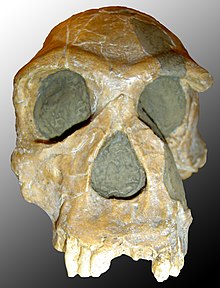Homo habilis
| Homo Habilis | |
|---|---|

| |
| Ìṣètò onísáyẹ́nsì | |
| Ìjọba: | |
| Ará: | |
| Ẹgbẹ́: | |
| Ìtò: | |
| Ìdílé: | |
| Ìbátan: | |
| Irú: | H. habilis
|
| Ìfúnlórúkọ méjì | |
| †Homo habilis Leakey et al., 1964
| |
Homo habilis (pípè /ˈhoʊmoʊ ˈhæbəlɨs/ "Handy-man") is a species of the genus Homo, which lived from approximately 2.3 to 1.4 million years ago at the beginning of the Pleistocene period.[1] The discovery and description of this species is credited to both Mary and Louis Leakey, who found fossils in Tanzania, East Africa, between 1962 and 1964.[2] Homo habilis (or possibly H. rudolfensis) is the earliest known species of the genus Homo. In its appearance and morphology, H. habilis is thus the least similar to modern humans of all species in the genus (except possibly H. rudolfensis). H. habilis was short and had disproportionately long arms compared to modern humans; however, it had a less protruding face than the australopithecines from which it is thought to have descended. H. habilis had a cranial capacity slightly less than half of the size of modern humans. Despite the ape-like morphology of the bodies, H. habilis remains are often accompanied by primitive stone tools (e.g. Olduvai Gorge, Tanzania and Lake Turkana, Kenya).

|
Àyọkà yìí tàbí apá rẹ̀ únfẹ́ àtúnṣe sí. Ẹ le fẹ̀ jù báyìí lọ tàbí kí ẹ ṣàtúnṣe rẹ̀ lọ́nà tí yíò mu kúnrẹ́rẹ́. Ẹ ran Wikipedia lọ́wọ́ láti fẹ̀ẹ́ jù báyìí lọ. |
Itokasi
[àtúnṣe | àtúnṣe àmìọ̀rọ̀]- ↑ New York Times article Fossils in Kenya Challenge Linear Evolution published August 9, 2007 says "Scientists who dated and analyzed the specimens — a 1.44 million-year-old Homo habilis and a 1.55 million-year-old Homo erectus — said their findings challenged the conventional view that these species evolved one after the other. Instead, they apparently lived side by side in eastern Africa for almost half a million years."
- ↑ Richard Leakey describes the discovery and naming of the first H. habilis in The Making of Mankind, pp 65-66 of the Dutton 1981 hardcover edition. It was found by Jonathan Leakey at Olduvai, and was called at first "Jonny's child." Leakey says that Louis named the species for its "ability to make tools " and that habilis means "skillful". By another account (see the notes for Louis Leakey) Louis solicited a name from Raymond Dart, which Phillip Tobias translated as "handyman." Later it became OH 7 described under "Famous specimens" below.
